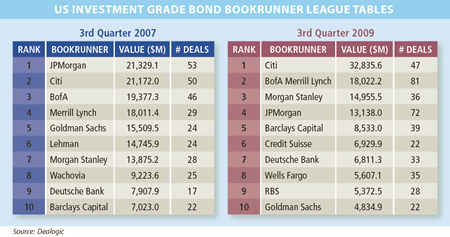By Dwight Cass
The crisis thinned the herd, but survivors aren’t as irreplaceable as they think.
The financial crisis thinned the banking world’s herd. But its survivors are not as irreplaceable as they might like to think. Big underwriters have been shepherding trillions of dollars of debt to market this year, collecting significant fees while having to put little risk-adjusted capital on the line. But some treasurers and investors argue that these firms are more or less interchangeable. The story with bank lending is more complex—a number of factors still constrain the availability of credit. But treasurers with pending loan renewals or those looking for new money are not wholly without their options, either.
Take underwriting. After investor risk appetite rebounded in the second quarter, bond dealers had a field day. Global corporate bond issuance totaled a record $1.8 trillion in the first half, and the full-year figure is expected to top $3 trillion. But despite the shakeout during the credit crisis the business remained largely in the hands of the big firms that handled most deals before the meltdown.
This is reflected in the US investment grade bond league tables below. They show the rankings for the third quarter of this year and for the same period in 2007, just before the bond market ground to a halt. Oddly, no firm actually fell off the list—even the failed or acquired firms are still represented in the guise of their new owners.
This relative stasis has been punctured at the margins by upstarts like Ken Griffin’s hedge fund, Citadel Investment Group, which last month debuted as an underwriter on a high-yield offering. Leveraged buyout shops Kohlberg Kravis Roberts and Apollo Advisors have also built underwriting capabilities. But these initiatives are epiphenomena when compared with the massive deal flows still handled by traditional underwriters.
COMPARATIVE (-LY SMALL) ADVANTAGE
Investment bankers argue that this is because the bulge bracket has peerless skills in pricing and distribution. But some issuers and investors disagree. For example, a senior analyst at one of the biggest US fixed income asset managers believes the difference in the ultimate yield on a bond underwritten by a top firm, compared with one of the worst, is a mere five basis points. The analyst, speaking at The NeuGroup’s Tech20 Treasurers’ Peer Group meeting last month, said the list of potential investors is about the same, no matter which firm is on the left of the prospectus. And since pricing is based on market trading levels, and new issue premiums fall in a fairly narrow range, underwriters have little scope to add value.
Underwriters’ sway over pricing has been further eroded over the past decade by the growing power of big bond investors. Consolidation—such as BlackRock’s recent purchase of BGI, resulting in a multi-trillion-dollar behemoth—and growth in assets under management this year at other major fixed income asset managers like PIMCO, SSgA, Aberdeen, WAMCO and TCW, have enhanced the buy-side’s already notable clout.
This semi-commoditization of underwriting actually gives corporate treasurers an advantage—within reason, they can ignore the banks’ pitches based on purported skills, and make their choices based on share of wallet and other relationship considerations.
The situation in the lending market is, admittedly, quite different. Lending is the polar opposite of underwriting: after adjusting for the risk capital it requires, the business is often a loss leader. That wasn’t a problem when banks embraced the pass-the-parcel model, using credit default swaps or similar technologies to offload their ultimate risk to third parties like collateralized loan obligations, structured investment vehicles and the like. But those buyers collapsed during the crisis, meaning banks now are forced to put their own money at risk.
Their reluctance to do so, and pressure from regulators, has caused US banks to deleverage, cutting total assets from $12.6 trillion last year at this time to $11.75 trillion now, an unprecedented rate of decline, according to data from Syzygy Research Group. The Federal Reserve’s recent beta testing of its reverse repo system for draining excess reserves has also raised worries that the end to quantitative easing that this move signals would further crimp credit availability.

THE VALUE OF FRANCHISE VALUE
These and other concerns have caused banks to move share of wallet discussions front and center in their negotiations with borrowers. Treasurers report that banks are emphasizing their “franchise value“—that is, their ability to execute across a range of instruments and markets through the cycle, even during crises. With moves afoot in Congress to rein in or possibly break up big institutions, that pitch appears to rely perilously on government forbearance.
But there are hopeful signs elsewhere in the lending market. Foreign banks that have survived the crisis relatively unscathed, such as BNP Paribas and HSBC, are making inroads into the US. Although it remains to be seen whether these types of institutions can establish sturdy enough beachheads to compete when domestic US bank lending recovers, treasurers’ desire to diversify funding sources and relationships could bode well for relative newcomers with strong overseas track records.
Meanwhile, there are signs of easing. Spreads on both leveraged and investment grade loans have narrowed in recent months, CDS pricing linkages have become scarcer, and banks have begun offering tenors beyond 364 days. In this environment, treasurers are finding it difficult but nonetheless possible to achieve, at least in part, their funding and banking relationship goals (see “Fine-Tuning a Bank Group” below).
|
FINE-TUNING A BANK GROUP The financial crisis highlighted the shortcomings of many companies’ bank relationships. Facility renewals in the post-crisis environment offer opportunities to rework those relationships to ensure they’re more resilient and better serve strategic needs. Members of The NeuGroup’s European Treasurers’ Peer Group discussed several considerations at their meeting last month in Geneva:
|
Few expect a return to the easy credit days of 2004-2007. But there are veins of value to mine in banking and underwriting relationships nonetheless.